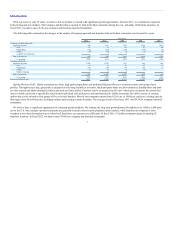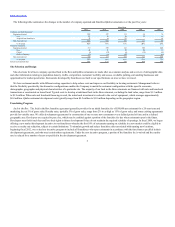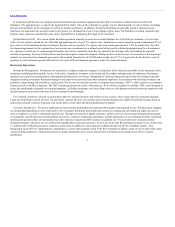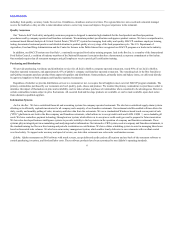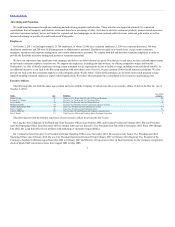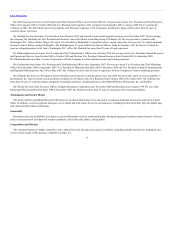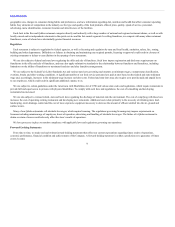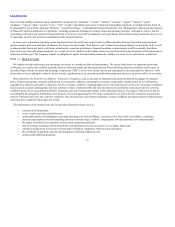Jack In The Box 2011 Annual Report Download - page 14
Download and view the complete annual report
Please find page 14 of the 2011 Jack In The Box annual report below. You can navigate through the pages in the report by either clicking on the pages listed below, or by using the keyword search tool below to find specific information within the annual report.
Table of Contents
Risk Relating to Competition and Successful Execution of our Operational Strategies and Initiatives. The restaurant industry is highly competitive
with respect to price, service, location, personnel, advertising, brand identification and the type and quality of food There are many well-established
competitors. Each of our restaurants competes directly and indirectly with a large number of national and regional restaurant chains, as well as with locally-
owned and/or independent quick-service restaurants, fast-casual restaurants, sandwich shops and similar types of businesses. The trend toward convergence
in grocery, deli and restaurant services may increase the number of our competitors. Such increased competition could decrease the demand for our products
and negatively affect our sales and profitability. Some of our competitors have substantially greater financial, marketing, operating and other resources than
we have, which may give them a competitive advantage. Certain of our competitors have introduced a variety of new products and engaged in substantial price
discounting in the past, and may adopt similar strategies in the future. Our promotional strategies or other actions during unfavorable competitive conditions
may adversely affect our margins. We continue to make improvements to our facilities, introduce new, higher-quality products, discontinue certain menu
items and implement new service and training initiatives. However, there can be no assurance that our facility improvements will foster increases in sales and
yield the desired return on investment, our new products, service initiatives or our overall strategies will be successful, or competitive product offerings,
pricing and promotions will not have an adverse effect upon our sales results and financial condition. The success of our strategy depends on, among other
factors, our ability to motivate restaurant personnel and franchisees to execute our initiatives and achieve sustained high service levels.
Risks Related to Increased Labor Costs and Regulation. Various federal and state labor laws govern our company and franchise operations and
employee relationships, including minimum wage, overtime, working conditions and fringe benefit requirements. We have a substantial number of employees
who are paid wage rates at or slightly above the minimum wage. While execution of our Jack in the Box refranchising strategy has and continues to reduce our
overall employee count, increases in federal, state and local minimum wage rates increase labor costs for us and our franchisees. If competitive pressures,
adverse economic conditions or other factors prevent us from offsetting the increased costs by increases in prices, our profitability may decline. In addition,
the cost of compliance with regulation, including the Patient Protection and Affordable Care Act, could increase our expenses, which could negatively affect our
results of operations and financial condition.
Risks Related to Advertising. Some of our competitors have greater financial resources, which enable them to purchase significantly more television and
radio advertising than we are able to purchase. Should our competitors increase spending on advertising and promotion, should the cost of television or radio
advertising increase or our advertising funds decrease for any reason, including reduced sales or implementation of reduced spending strategies, or should our
advertising and promotion be less effective than our competitors, there could be a material adverse effect on our results of operations and financial condition.
Also, the trend toward fragmentation in the media favored by our target consumers poses challenges and risks for our marketing and advertising strategies.
Failure to effectively tackle these challenges and risks could also have a materially adverse effect on our results.
Taxes. Our income tax provision is sensitive to expected earnings and, as those expectations change, our income tax provisions may vary from quarter-to-
quarter and year-to-year. In addition, from time to time, we may take positions for filing our tax returns that differ from the treatment for financial reporting
purposes. The ultimate outcome of such positions could have an adverse impact on our effective tax rate.
Risks Related to Achieving Increased Jack in the Box Franchise Ownership and Reducing Operating Costs. At October 2, 2011, we had reached the
low-end of our target range of franchise ownership under our refranchising strategy, with approximately 72% of the Jack in the Box restaurants being
franchised. We plan to continue to implement our strategy to increase the percentage of franchise restaurants to approximately 80%, a level of franchise
ownership more closely aligned with that of the quick service restaurant industry. However, this strategy is subject to risks and uncertainties and we may not
be able to achieve or maintain the ownership mix of franchise to company-operated restaurants that we desire. We may not be able to continue to identify
13


